Personal Capital is free financial website and app that links all of your accounts to track your spending via bank and credit cards, investments, and net worth. You provide your login information, and they pull in the information for you automatically so you don’t have to type in your passwords every day on 7 different websites. Personal Capital’s strength is in investments, including portfolio tracking, performance benchmarking, and asset allocation analysis.
Net worth. You can add your home value, mortgage, checking/savings accounts, CDs, credit cards, brokerage, 401(k), and even stock options to build your customized Net Worth chart. You can also add investments manually if you’d prefer. I have a habit of accumulating bank and credit union accounts, so I find account aggregation quite helpful.
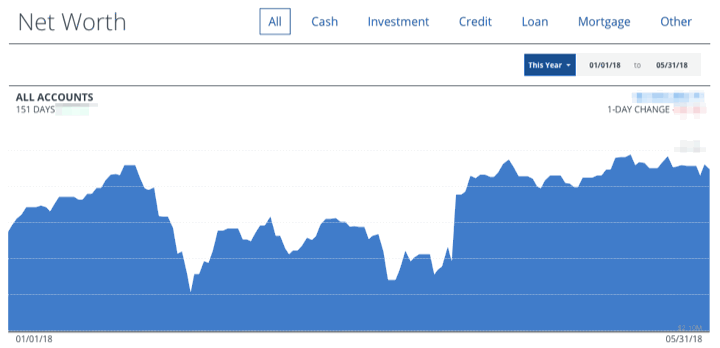
Cash flow. The Cash Flow section tracks your income and expenses by pulling in data from your bank accounts and credit cards. This chart compares where you are this month against the same time last month. If you hate budgeting, you may find it easier to view a real-time snapshot of your spending behavior. Their expense categorization tool is pretty accurate, and if it isn’t you can change it manually. However, it isn’t quite as advanced as Mint.com, where you for example you can make a rule to always classify “Time Warner Cable” as “Utilities” and not “Online Services”.
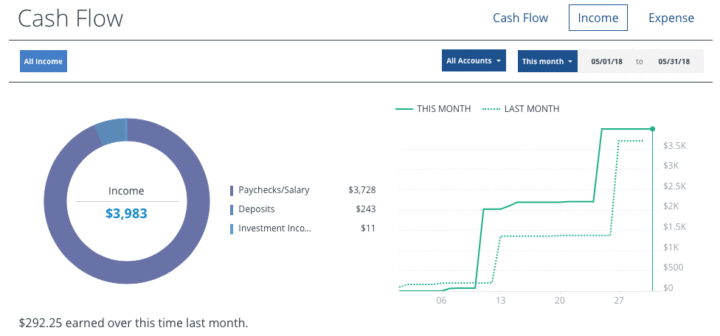
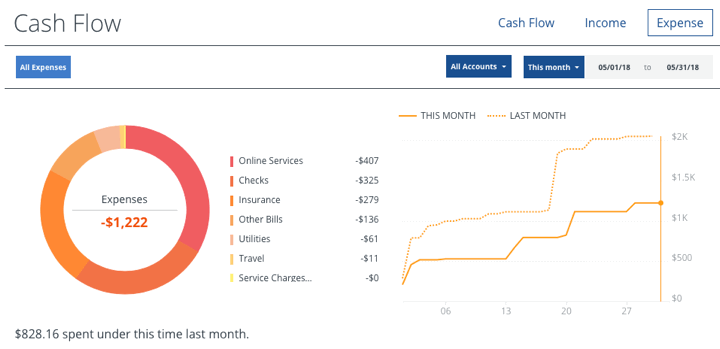
Portfolio. This is where Personal Capital is better than many competing services, by analyzing my overall asset allocation, holdings, and performance relative to benchmarks. If you’re like me, you have investments spread across multiple custodians. I now have investments at Vanguard, Fidelity (401k), Schwab, TransAmerica (401k), and Merrill Edge. It’s nice to be able to see everything together in one picture. They can also analyze your retirement accounts fees to see if you are quietly getting charged too much.
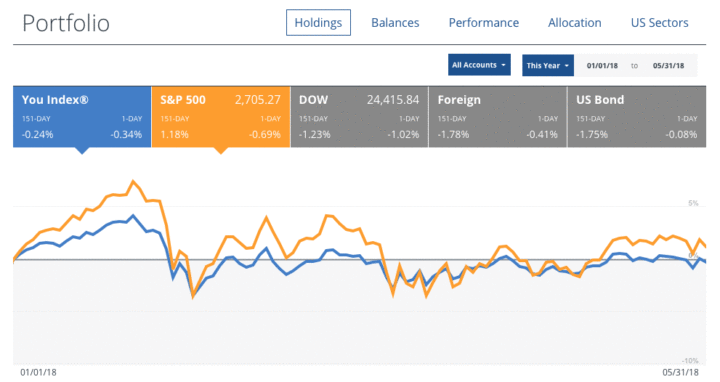
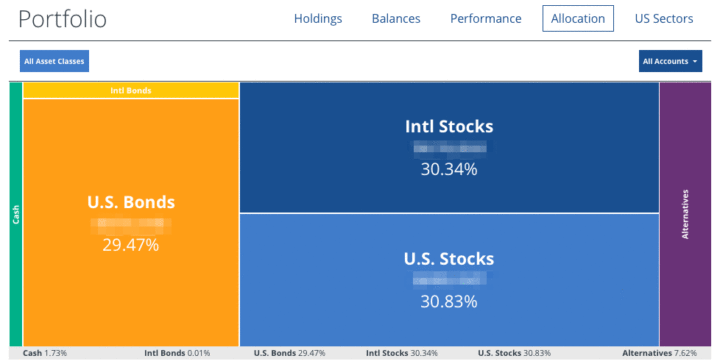
For comparison, Mint did not allow manual input of investments and it did not break down my asset allocation correctly based on my linked accounts. In fact, all it shows is a big orange pie chart with “99.9% Not Sure” and “0.00 Other”.
Personal Capital considers the major asset classes to be US stocks, International stocks, US Bonds, International Bonds, and Cash. The “Alternatives” classification includes Real Estate, Gold, Energy, and Commodities.
If you have one bank account, one credit card, and a 401(k), you may not need this type of account aggregation service. Life tends to get messy though, and this helps me maintain a high-level “big picture” view of things.
Security. As with most similar services, Personal Capital claims bank-level, military-grade security like AES 256-bit encryption. The background account data retrieval is run by Envestnet/Yodlee, which partners with other major financial institutions like Bank of America, Vanguard, and Morgan Stanley. Before you can access your account on any new device, you’ll receive an automated phone call, email, or SMS asking to confirm your identity. Their smartphone apps are compatible with Touch ID/Face ID on Apple and mobile PINs on Android devices.
In terms of the big picture, my opinion is that by making it more convenient, I am able to keep a closer eye on all my account and thus actually make myself less likely to be affected by a security issue.
How is this free? How does Personal Capital make money? Notice the lack of ads. Personal Capital makes money via an optional paid financial advisory service, and they are using this as a way to introduce themselves. (People who sign up for portfolio trackers tend to have money to manage…) They are a hybrid advisor, combining their online tools with real human access. Their management fees are 0.89% annually for the first $1 million, with slightly lowered pricing as you go past $1 million in assets. As an SEC-registered RIA fiduciary that now manages over $7 billion, I think this improves their credibility as a company built to handle sensitive information.
Note that if you give them your phone number, they will call you to offer a free financial consultation. If you answer the phone or e-mail them that you don’t want to be contacted anymore, they will honor that request. Or you could ask them your hardest financial question and see how they respond. However, if you simply ignore the phone calls, they will keep calling. Now, you can keep using the portfolio software for free no matter what happens. But, if you aren’t interested, I would highly recommend simply being upfront with them. A simple “no thank you” and you’re good.
If you’re upfront with them, they’ll be upfront with you. I’m still a DIY guy when it comes to my money, and they have been happy to keep monitoring my accounts for free, without any additional phone calls over the last 5 years.
Bottom line. It’s not what you make, it’s what you keep that counts. The free financial dashboard software from Personal Capital helps you track your net worth, cash flow, and investments. I recommend it for tracking stock and mutual fund investments spread across different accounts. I’d link your accounts on the desktop site, but interact daily through their Android/iPhone/iPad apps for optimal convenience (log in with Touch ID or mobile-only PIN).
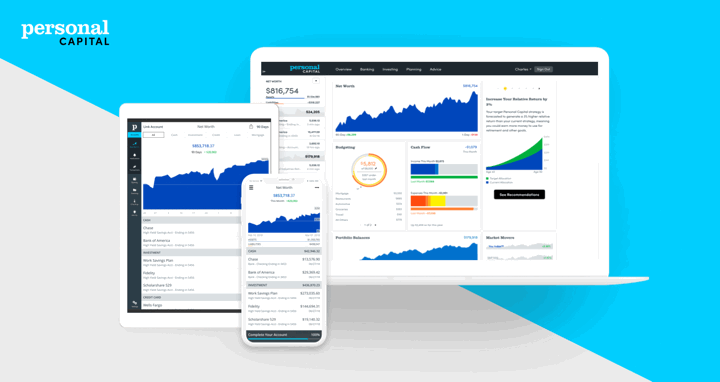
 The Best Credit Card Bonus Offers – 2025
The Best Credit Card Bonus Offers – 2025 Big List of Free Stocks from Brokerage Apps
Big List of Free Stocks from Brokerage Apps Best Interest Rates on Cash - 2025
Best Interest Rates on Cash - 2025 Free Credit Scores x 3 + Free Credit Monitoring
Free Credit Scores x 3 + Free Credit Monitoring Best No Fee 0% APR Balance Transfer Offers
Best No Fee 0% APR Balance Transfer Offers Little-Known Cellular Data Plans That Can Save Big Money
Little-Known Cellular Data Plans That Can Save Big Money How To Haggle Your Cable or Direct TV Bill
How To Haggle Your Cable or Direct TV Bill Big List of Free Consumer Data Reports (Credit, Rent, Work)
Big List of Free Consumer Data Reports (Credit, Rent, Work)
Nice review! I still prefer to use Microsoft Money (a FREE, private desktop PC program) for tracking my spending, investments, and net worth. Used in conjunction with Pocketsense (also FREE and runs from your PC), which are a set of Python scripts that perform the same online functions, it pulls in the information from all of your accounts for you automatically from the same OFX servers on a daily basis, and no one else in the cloud sees your passwords or data.
Well, I do admire your tenacity in keeping things working with MS Money. Wasn’t that software last updated in 2009 or 2010?
Thanks 😉 It still works perfectly!
Speaking of — I have an obsolete version of Microsoft Money (1997 edition I believe) that I use on my Windows 7 computer. I have a bad feeling that the next time I upgrade my computer that it will not successfully load. For that reason I have been exploring other options. Offerings from Quicken seem to be a bit pricey, unless you can catch a good sale. I have been intrigued by Personal Capital (hard to beat free) but have been a bit wary of any “hard sell” I might encounter for their services. Your article is reassuring in this regard. So now I have to get over my mental hurdle about connecting all my accounts to one site. I guess I’m a luddite, but I’ve stubbornly stayed with manual entry of data out of security concerns. One question though — can you bring in a spouse’s IRA/workplace retirement accounts to get an entire household picture — or is it strictly on an individual basis?
I don’t think they check specific names. I believe that if you provide a login and password, they will link and consider it all part of your overall picture.
gabrewer,
Click on my name and you can read all about upgrading Money to the Sunset edition. We’re all using it under Windows 10, so may it live forever.
This post reminded me that I have a Personal Capital account. I think I only ever access my profile though their iOS app. When i went to log in this morning, I had to do a password reset. But there is a bug in their password reset app, and I’ve been told by a few people at Personal Capital to wait 3 days for some kind of “System Reset”.
You review is great, but unfortunately, their customer service is lacking.
I don’t trust them with my account log in credentials. Keep in mind that PC is just basically a small RIA with a fancy website and app. The interface is very nice but I trust Intuit/Mint more. Intuit has substantially more financial resources dedicated to keeping account information secure. Intuit makes money through advertising as opposed to this RIA that wants to sell me investment management services that I can get thru a Robo advisor at a fraction of the cost.
Intuit and Yodlee are probably the two biggest account aggregation services. Vanguard manages over $3 trillion and just recently inked a new deal with Yodlee. Since Yodlee is what is storing your login credentials, I’m equally okay with Mint and Personal Capital. “Your bank and brokerage credentials are only stored at Yodlee, not in Personal Capital’s database.” Mint is better at expenses, Personal Capital is better at investments. Mint can’t figure out my investments, here’s what they show me:
https://www.mymoneyblog.com/wordpress/wp-content/uploads/2017/02/pc_mintaa.gif
Haha, Mint was also just a “fancy website” that sold to Intuit for $170 million. Even if you think a RIA managing $3.6 billion is “small”, Personal Capital still takes on a fiduciary duty to their clients. Before Intuit bought them, guess what Mint used for account aggregation? Yodlee.
You don’t have to click on the ads on Mint, and you don’t have to pay for the advisory services on Personal Capital. One requires ignoring their “recommendations” every time you log in, and the other requires you to say “No Thanks” once on the phone or via e-mail. I use both.
Good explanation. I tend to agree with you re Yodlee as they were handling all the credentials for Money when the servers were active. I’ve got every single purchase I’ve made since 1995 in my data file, so I can pull up details on a micro level, and Money assigns the categories correctly.
If I were just starting out, I might consider Personal Capital having read your review, but I’m a Money diehard.
Rubin,
Maybe you should look more into what Personal Capital does and offers, they are not just another RoboAdvisor and they aren’t a one size all kind of service. They customize to how you want things because of personal/religious beliefs. They, also, will review your 401k options and let you know the best way to allocate them to coordinate with the money that they manage for you.
I never stated that Personal Capital is a Robo Advisor. My total (and I mean total expenses) on my current Robo advisor account with another firm is 19bps and was up 11% last year. I don’t need any more customization than what my Robo provides and don’t need any other advisory services. So for me, my Robo and Mint setup works fine. There is nothing that PC offers that is worth paying an extra 60bps for IMHO.
being a cybersecurity professional, I too am skeptical about logging into my accounts through personal capital
there is a workaround though — after creating a support ticket with them you can bypass the initial account linking screen by navigating straight to where you can manually add in your accounts
MMM, How do I create a support ticket? I can’t sign in without keying my login credentials for bank accounts.
I really like what Personal Capital does, even if their fee is a little on the high side. Though I do wish their budgeting side of things was stronger.
For anyone interested in having Personal Capital managed their money know that if you get referred by an existing client you both get 3 months of fee-free service. (I would post my referral link here for interested parties to use but I don’t know what Jonathan’s policy on that is.)
I’m interested in a referral link if you still have one Michael. Thanks.
Good review. I don’t understand “manual entry.” Do you still have to give the program sign-on info for all your accounts? From their enrollment page, there is no other alternative. So, what makes manual entry special if the program can access your accounts anyway?
No, you don’t have to give the program your sign-on info if you don’t want to. For example, you can tell them you have 200 shares of Apple stock if you want, and they will just track that. (You can also provide cost basis if you want them to track gains/losses.) Mint doesn’t allow this that I could find.
I didn’t know we can enter our investments manually. Can you please explain how ?
Log into your account, then click on the + button on the top left, then look at the bottom for a button that says “Add Portfolio”. Enter a name for your manual portfolio and then starting adding your positions. That’s it 😉
Manual entry is also good if you have investments at a company that Personal Capital/Yodlee doesn’t currently have setup for automated account aggregation so that they can be included in your net worth and investment allocation reporting.
I use both Personal Capital and Mint + Mojito Chrome Extension. The Mojito extension gets rid of all the ‘recommendations’ and adds some other nice stuff like transaction search by dates or even a loan calc. You should check it out!
Are there any recommendations for good free desktop personal finance software? I do not want to connect to cloud with my financial data. I downloaded and reviewing Money Sunset deluxe lately.
I feel a little anxious about giving all my account numbers and information to this company to monitor my holdings. I have included outside accounts in my Vanguard overview and have Total View with Ameriprise, but they are big, well-established companies. Am I just being paranoid here? Can this company use my information to, you know, empty my accounts?!? Thank you!
When I shared this article with my wife, that was her exact concern as well! We’re still doing quarterly updates using pencil and paper. We’re pretty conservative with our investments and ONLY have our retirement money in indexed stock and bond funds. Most of the rest is in bank accounts and a little in real estate.
Another great post on asset allocation and spending tracking. I recently blogged about Asset Allocation and our points were actually aligned.
The only thing we would see different is giving out account data to a company just so they can monitor our holdings.
Wow 2.5 million dollars. That’s impressive.
Personal Capital isn’t able to upload treasurydirect.gov data
Not sure what you mean by ‘upload’ by it definitely can link to treasurydirect.gov
Perhaps they were having trouble with it at a previous time, but yes you can link your TreasuryDirect.gov account in Personal Capital now.
You may be able to technically do it, but Treasury Direct is the one account on both Personal Capital and Last Pass that I do NOT let the software automatically log in to. When things go wrong with an automatic login, your account can get locked.
At a normal bank or brokerage, this means going through some security questions as their “Forgot My Password” procedure. At Treasury Direct it means some cumbersome process that involves getting a bank guarantee and a much longer amount of time and effort. The Bogleheads forum is full of people who swear off Treasury Direct because of this.
I am fine with Treasury Direct, but I respect it’s quirkiness by manually entering the numbers every so often on Personal Capital and only storing a “secure note” on Last Pass rather than automatically logging in.
Good points, thanks for sharing. I also try not to deal with TreasuryDirect too much.
Actually, Treasury Direct is almost always asking me to validate on Personal Capital with an additional, unique passcode that is sent to my email that is only valid for a few minutes. This password is then entered into Personal Capital to refresh data. I can’t imagine a more secure system. It’s actually a pain, but I only process the extra validation once or twice a month at most; usually month end, and ignore it otherwise. It won’t refresh Treasury Direct data without it. For some reason this seems to work better in Internet Explorer than Chrome.
This same system (passcode to email) seems to appear every few months if I log into Treasury Direct directly, re-authorizing my PC —or, if I log into Treasury Direct on a different system.
I’ve been using Treasury Direct with Personal Capital for about a year and a half now without any issues.
How were you able to link Personal Capital and TreasuryDirect? I would like to link my treasury direct account to Personal Capital but when I search for “TreasuryDirect” it doesn’t appear….is there another name in the search field I should be utilizing? Thanks in advance!
So I was skeptical of using Personal Capital for a long time, until I talked to friends and co-workers that were using the site and have been for years. I finally started using the service about a year and a half ago, and it’s worth it for the retirement fee analyzer alone. It’s an eye-opener to not only see your fees, but calculate them until you’re projected retirement date. I knew my fees were high for the work 401k, but I had no idea how much I was paying overall. That feature alone helped me reshape my investments.
I do like the net worth calculator and I’ve begun to use the cash flow feature to see how much I’m spending by month, which is helpful for me in figuring what I’ll need in retirement.
The only feature that I would like to see them add is some type of report option. There’s limited export for non IE browsers, but I’d like to be able to save a monthly or year-end PDF report with the graphs.
Personal Capital manages a seven figure account for me as well as being a great aggregator. Fees are 0.79% for that size account and they’ve been handling it for two years. They use a smart beta approach that is not nearly as concentrated on the FANG stocks as almost every US index fund is. I like the diversity of having money at Vanguard, Betterment and Personal Capital as well as in a privately controlled brokerage account. I’m particularly looking forward to how the relative approaches handle the next bear market someday, maybe someday soon.
How do you like their advisory services now? Are they still good I am thinking of enrolling next month.
I thought they were just fine, but after a couple years wanted to have more control myself so I left. To my surprise the second I told them I was leaving they switched my account to a free one, which I expected, and purged my Personal Capital accounts from my dashboard. Three years of history gone in an instant.
So be aware that if you like to use them to get the whole picture of your Net Worth, that when you leave they purge all of the data from the accounts that they were managing. I contacted them to let them know how I felt about that and they said it was a limitation of their system and there was nothing they could do about it. But they may at some point in the future make changes so that you could keep your account history when you leave them.
Speaking of Betterment, has anyone analyzed their Betterment account with Personal Capital and noticed it’s lagging? YTD, as of today, I show a .44% return with Betterment on what they considerate a moderate 80/20 split. When I log into Betterment, it says I’m getting 4% annualized simple earnings. You can’t select a term. I’m unclear if Betterment is giving me a decent return. According to Personal Capital, I am not.
To start, I’ve been following your site for a little over 10 years when I stumbled on the 0%/no fee balance transfer info. Lots of great info shared throughout the years and just wanted to thank you for that.
My thoughts on Personal Capital: I’ve been using it for a little under one year. I used Yodlee prior to that due to it’s simplicity. I really like Personal Capital also due to it’s simplicity. I think the only thing I would like to see is the ability to add manual bills. Other than that I think it’s great.
Thanks for reading all these years. Personal Capital actually uses Yodlee for the back-end account integration, but I like the additional stuff they have created on top.
I’ve been very happy with this software. The account linking was super easy and it gives me one place to view my net worth, my investments, etc. I haven’t figured out their cash flow completely and I track that with an Excel spreadsheet. They do keep calling to offer me a free financial review but I’ve never answered the phone when it was them calling. Thought I emailed them to let them know I am happy with my current Financial Advisor.
Have you seen Nummo? What are your thoughts?
Personal Capital looks very nice but unfortunately doesn’t work for those outside the US. I have searched high and low for a good program and settled on https://www.stockportfolioorganizer.com only thing it’s missing is the ability to compare portfolio performance to the index and the ability to view my portfolio on my phone.
Jonathan, just read these comments on Personal Capital. I am currently using Fidelity’s Full View for external account linkage. I was wondering if you have been introduced to any other platforms for account integration, asset allocation etc. Fidelity has been upgrading their system but I am still not totally happy. Thanks!
Personal Capital is about to be sold, according to Barrons.